Leopard geckos shed their skin throughout their entire lives. But, unlike mammals, reptiles shed their skin all at once and not continuously.
If their diet and environment are right, usually geckos shed without a problem.
Some owners will see no shedding issues over their pet’s lifespan. But, it is always best to know what to do if health problem arise. Even a normal shedding cycle can be worrisome for first-time owners.
If you are looking for a complete guide to leopard gecko shedding, then continue reading…
We cover how, why, and when your gecko will shed. We also discuss symptoms, behavioral changes and tips for solving common shedding problems.
Why Do Leopard Geckos Shed?
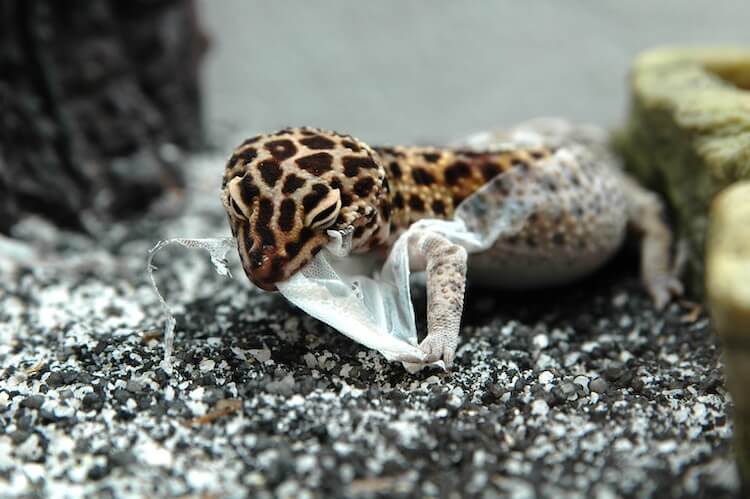
Reptiles shed for many different reasons. The most important one is to help make room for new skin as they grow. Shedding also helps them remove external parasites, develop their adult coloration, conserve nutrients, as well as heal from injuries or damage to the skin.
In the wild, shedding can keep away parasites like ticks and mites that could otherwise cause illnesses. Successive shedding over months can also help them recover from bites, scratches, or other minor injuries.
However, shedding is not limited to wild species.
Healthy, pet leopard geckos shed regularly as they grow, replenish their skin cells, and change skin color.
Though most people say a leopard gecko is “shedding its skin”, in reality only the top layer of skin is lost. This layer is called the epidermis. The epidermis is a protective layer that shields their body from microscopic and macroscopic elements.
Age, diet and habitat determine the frequency and ease with which your et sheds. However, younger species grow faster than older individuals and so shed more often.
Leopard Gecko Shedding Behavior
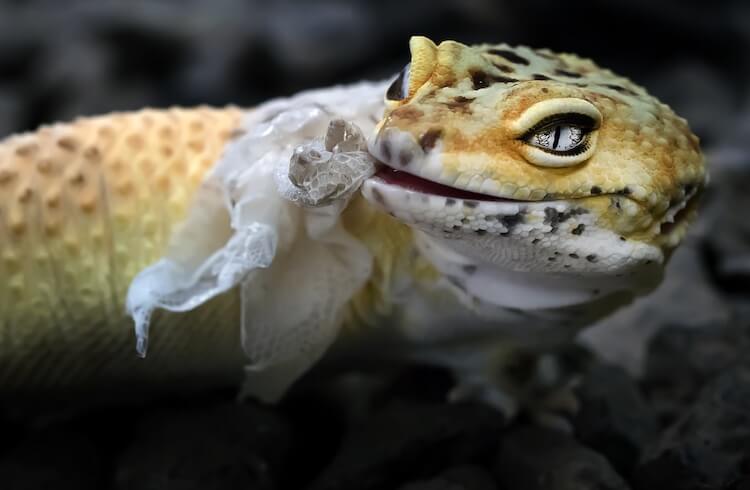
There are some behavioral and physical signs to look out for that will tell you when your leopard gecko is ready to shed. These signs vary slightly between individuals, but are all good indicators that they will soon shed.
Leopard geckos getting ready to shed will grow dull and their pattern will fade into a gray color. At this point, water and nutrients from the old skin get absorbed into the body to help grow new skin.
As the new skin is grown, a layer of lymph fluid collects between the old and new layers. This pushes the old skin away, making your gecko look pale and papery.
Once the new layer of skin is ready, and the old layer is dried out, they will rub against a rough object or use its mouth to pull the shed skin off of its body. The new skin will be bright and colorful.
They can shed once or twice a month as hatchlings and juveniles.
From six months old, your lizard will shed less frequently at a rate of once every three weeks.
By the time they reach their adult size geckos will shed every four to eight weeks. There are also times when your lizard may temporarily stop shedding (e.g. brumating or incubating eggs).
| Age | Shedding Frequency |
|---|---|
| Under 3 months | Weekly or biweekly |
| 3 to 6 months | Once every 1 to 2 weeks |
| 6 months to 1.5 years | Monthly |
| 1.5 years+ | Once every 4 to 8 weeks |
Leopard geckos that are close to shedding will not be interested in food. But, as soon as leopard geckos shed they should start eating regularly again. You may also see it eating its shed skin. This is normal and helps your lizard get nutrients.
Many leopard geckos become lethargic, shy, or even irritable during their shed.
From the time their skin pales gray to when they shed, they may hide more than usual or not want to be handled. Because of this, try not to handle your lizard until three days after it has completely finished shedding.
How Long Does Shedding Last?
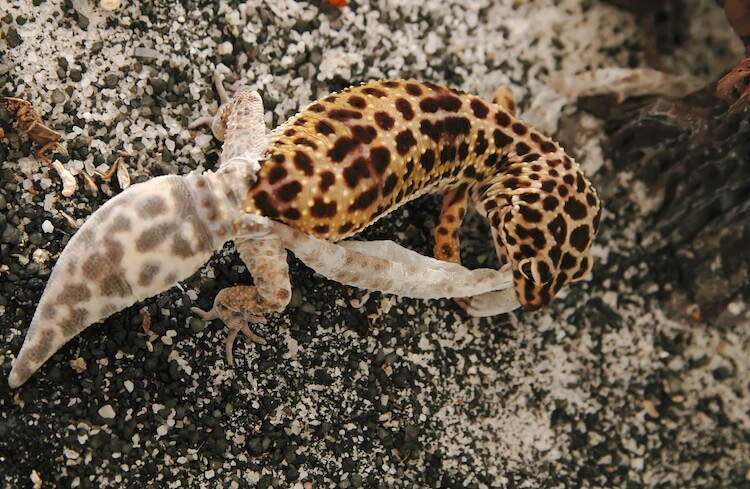
Shedding is a regular part of a leopard gecko’s life. It is not a difficult or long process for a healthy lizard.
After you notice your pet is entering a shedding cycle (i.e. its skin starts to turn dull), it will usually take one to three days to shed. Once it starts to shed, however, the skin removal process itself usually takes an hour, though some geckos may take 24 hours.
Your leopard gecko may lose its appetite during the shed cycle. This is normal.
They use a lot of energy to grow new skin and shed the old layer.
When the two skin layers start to separate, it is normal for your leopard gecko to become sluggish and lethargic. This lethargy is not a problem as long as your lizard returns to its usual energy levels after shedding.
Pets that remain lethargic, even three days after their shed, may have another health problem.
In the days leading up to shedding, you can feed your leopard gecko if it is hungry. Once it starts to shed, however, wait until it is finished before offering more food.
The process of removing old skin leaves them vulnerable to predators.
Stressing a reptile that is in the middle of a shed by handling it or introducing food can lead to shedding problems. They will be irritable, even on good days. It is best to leave your lizard alone in its tank while it sheds.
Why Is My Leopard Gecko Not Shedding?
When leopard geckos age and get older they may shed less frequently.
Sometimes, you may not notice your lizard shedding, especially if it sheds at night. This can make it seem like your leopard gecko is not shedding at all when it actually is.
If your lizard is otherwise healthy, growing, and eating, it is still shedding; you just may be missing the actual shedding period.
Some individuals will temporarily stop shedding if they are ovulating or incubating eggs. Growing eggs takes a lot of energy, so pregnant females may hold off on shedding until after they lay a clutch of eggs.
How To Help A Leopard Gecko Shed
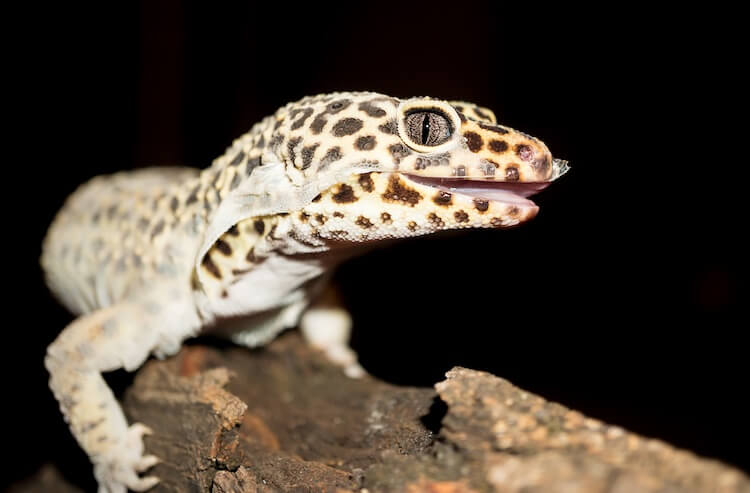
It is important to monitor, and sometimes help, your pet during its shed.
Though rare, shedding problems can cause limb loss and injury. Leaving stuck shed, especially on the toes and tail, can cause your leopard gecko to lose these digits as the shed constricts blood flow.
The best thing you can do to help your leopard gecko successfully shed is to set up the proper enclosure.
If your leopard gecko’s habitat and diet are right, they should have no trouble shedding. In general, you should not try to pull of stuck shed yourself.
Pulling off stuck shed can damage the delicate skin underneath. Soaking, misting, and bathing make it easier for your lizard to remove the shed itself.
Below are our top three tips to make sure your gecko will have no trouble shedding.
1. Habitat
Proper temperatures, décor, and humidity are essential for shedding health. Leopard geckos are arid lizards that prefer dry habitats. Because of this, some new owners fail to recognize that this species still needs an area with high humidity to shed properly.
40% humidity is best for leopard gecko shedding, however, too much or too little humidity can cause problems. Do not let humidity drop below 30%. Low humidity dries out the old skin layer and makes it much more difficult to peel away.
Providing a shed box or a hide with coconut fiber or sphagnum moss that remains damp in the tank is a great idea. The hide should be moist enough to form condensation on the sides, but not too wet that water is dripping from the walls or top.
This hide will provide your lizard with a humid environment for shedding.
You will also need to make sure your gecko has rough décor to rub against during shedding. This can be anything from the edge of a plastic hide to sticks, rocks, and branches. These surfaces should be rough enough to loosen shed skin, but not too sharp that they would cut your gecko.
2. Diet
A proper diet is a great way to not only avoid shedding issues but also many other health problems too.
Unlike some lizards like the blue-tongued skink, leopard geckos are insectivores. They need an all-insect diet to stay healthy and happy.
Vitamin A deficiency is a dietary cause of abnormal shedding and can be caused by feeding the wrong diet.
Leopard geckos should eat crickets, Dubai cockroaches, mealworms, or super worms. Insects should be dusted with a vitamin powder supplement.
3. Lighting
It is a common misconception that leopard geckos are nocturnal and do not need any special lighting.
This species is most active at dawn and dusk, and so are exposed to sunlight in the wild. As pets, they need UVB light. This helps them convert calcium into vitamin D.
The presence of UVB makes shedding easier for you lizard. It also helps them to fully metabolize food and avoid vitamin deficiencies.
Usually shedding is nothing for keepers to worry about. The best thing you can do for your lizard while it sheds is leave it alone.
Leopard Gecko Stuck Shed
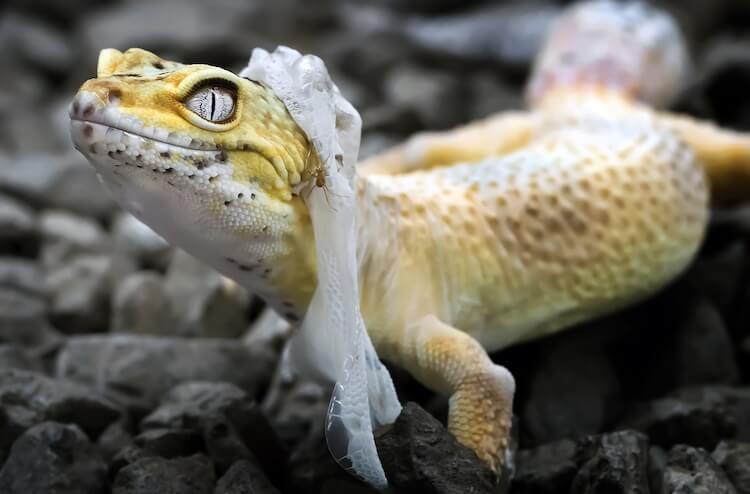
Problems with a lizard’s environment, diet and health can disrupt the shedding process. ‘Dysecdysis’ is the scientific term used for retained or stuck shed. Stuck shed is not an illness, but a side effect of a husbandry or healthy condition.
Stuck shed is usually caused by poor diet or humidity.
External parasites, low vitamin A, or a severe injury can also lead to stuck shed. Leopard geckos that are injured or carrying parasites will typically show other signs or poor health (e.g. thin tails or lethargy for more than a few days).
If you notice your reptile still has shed stuck to its body after 24 hours of shedding, don’t panic.
There are several things you can do to help your lizard get rid of its retained shed right away. Here are five simple ways you can help a leopard gecko shed:
1. Bathing
Fill a plastic container with two centimeters of lukewarm water.
Place your gecko in the container, making sure the water is not above chin level. Leave your lizard to soak for 10 minutes, or until the water begins to cool off.
Soaking can loosen shed and make it easier for them to remove.
There is no need to bathe your leopard gecko if it is not having trouble shedding. Only soak your lizard if it still has stuck shed 24 hours after it has finished shedding.
2. Misting
Misting your lizard directly can soften stuck shed, but never spray your leopard gecko directly on its face.
Spray your reptile gently with lukewarm water, letting it sit for 10-30 minutes and patting it dry.
A very fine mist works best.
If misting directly doesn’t work, then try a shedding aid.
3. Shedding Aid
Shedding aids are usually water combined with aloe, jojoba oil, and vitamin E. They are designed to be sprayed directly on the skin.
Most shedding aids work best when carefully rubbed into the dry skin with a Q-tip.
4. Shedding Box
When your lizard is ready to shed, having a humid hide to climb in can help them shed properly.
Fill a hide with one inch of damp sphagnum moss, paper towel, or coconut fiber. This hide should be large enough for your entire lizard to fit in, but only have a small opening to prevent evaporation.
If you provide your reptile with a humid hide for shedding, it is unlikely that you will need to bathe.
5. Décor
One of the most common reasons for stuck shed is a lack of rough surfaces for your lizard to rub on.
Many leopard geckos use their teeth to pull shed off of their bodies, but they will also rub against rough surfaces to get the spots they can’t reach with their mouths. Having nothing to rub on can leave shed stuck on their back, nose, or tail.
Summary
Shedding is a normal process that all leopard geckos go through. Most adults shed once every four to eight weeks.
When your lizard starts shedding you may notice them stop eating and act lethargic or irritable. Over the next two days, their color will grow dull and turn gray as the old layer of skin separates from the new layer.
You will see your leopard gecko rubbing against décor in its tank or biting at the loose shed. Afterward, your lizard will have a bright, fresh layer of skin and should return to its normal behavior.
If tank humidity is too low, or they are being fed the wrong diet, shed can remain stuck. This is called dysecdysis can cause your lizard to lose limbs or digits. To help with stuck shed, carefully soak or mist them with water or a reptile shedding aid.
Do you have any questions about shedding that we didn’t answer? Let us know in the comments below.

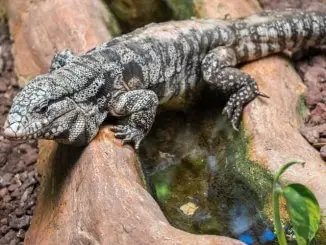
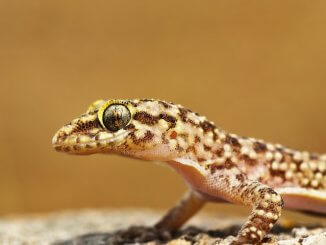
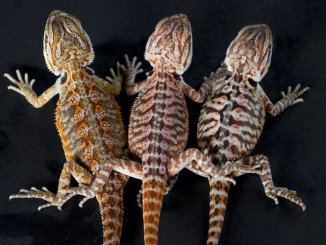

I have a leopard gecko that I’ve never witness it’s shed,as it was given to us because the person before us didn’t want him or her. I have him in a 10 gallon fish tank with a us lamp,water tray, food tray, a rock, and a toilet paper roll to hide in,and a puppy pad for a liner. I feed him every 3-4 days mealworms,and crickets with supplements powder. Do I need to get a different set up tank to make him happier? Please help me
First things first: how long have you had your gecko for? Do you roughly know its age? Keep in mind that geckos shed less and less frequently as they grow old, and can end up shedding only once every two months when they are around 2 years or older.
Having said so, there are still ways you can help your gecko shed its skin. For example give him more hiding and resting spots, by building a second hide with a slightly larger container able to retain moisture. Inside it, place a wet (not damp) coconut fiber or sphagnum moss bed which will provide some humidity to the hide, thus helping the shedding process. Remember that ideal humidity helps the skin to come off, and although leopard geckos live in arid grasslands and deserts, they are mostly active at dusk when humidity is between 30 and 40%.
This leads us to a second key aspect: UV light. Given your relatively small-sized tank (ideally you need twice as much for a leopard gecko) it might be that your UV bulb is too strong (or too close) to the animal, whose skin remains fairly permeable to UVB radiation (as we said, they are active at dusk!). You can check appropriate distance and bulb power at this link (https://reptilehaven.org/index.php/2020/04/21/uvb-lighting-for-your-reptiles/). Keep in mind that leopard geckos require a UVI between 0 and 1.2. The diet and rest of the setup seems ideal but feel free to give us more details.
Do leopard geckos like to drink water
Yes they do. It is crucial to provide water in the enclosure, and not only for drinking… By giving your gecko a small pool, you provide him one more tool to regulate its body temperature and humidity.
I am taking care of two leopard geckos and one of them just started to shed. The only problem is the one that is shedding does not like to be held by people because she is missing her claws. How do I deal with a shedding lizard that does not like to be helr?
You do not necessarily need to handle your gecko during shedding. On the contrary, handling should be limited to the bare minimum during this stressful time. We only handle them if we notice a stuck shed.
To help your gecko shed without handling you can do the following things: keep humidity levels in the higher end of its spectrum, this will help soften the shedding skin; Provide plenty of rough surfaces for your gecko to grind against, place one of these in his hide. These can include branches, trunks, rocks, anything works but do not put something too sharp that would risk causing injuries; Lastly, do not disturb your leopard gecko during this time. In fact, do not try to handle if not welcomed. Shedding is a delicate process in their natural environment, causing geckos to be exposed to a higher risks of predation. So a threat, despite how small it is, can actually cause quite a lot of stress during this time.
My 11 year old gecko just had a difficult shed( 24 hours ago) and still has skin stuck to her torso, tail and rear limbs. I tried soaking her, but that method is not working. Could you please give me the proportions of your shed aid with the jojoba oil and vitamin E? I want to try that pronto!!! Also, we do have mineral oil in the house, but i don’t know if that’s appropriate for a shed aid… Any other helpful hints would be appreciated! Thank you
Keep in mind that 24 hours is nothing to worry about. I wouldn’t intervene just yet. Make sure she has some rough (but not sharp) surfaces in her enclosure. A simple rock can do the job. Regarding the oil there’s not one correct answer but I used to do a 50-50 mix.